Since seeing is believing, if you want to witness Kaleidescape in your own house, contact us at Wicked Home Theater to arrange a demo. Updated April 2, 2025
Movies are at the forefront of the evolution of the theater experience. Growing up I had times that stuck out, because of the movies at that time. “Mysterious Island”, “2001”, “20,000 Leagues Under the Sea”, and then in 1977, a wide eyed 16 year old saw “Star Wars”. I saw it 12 times in the theater. That movie is the reason why I got into Home Theaters. I wanted other people to get that same chill down their spine as the star destroyer is flying over your head. “Star Wars” was revolutionary. Movies, generally, have gotten better since then. Action, sci-fi, adventure, fantasy, war, and epics. All make for great theater.
So what has got me all worked up about Kaleidescape? Well Sherman, set the way-back machine to 2004 when Wicked Home Theater was started. The Blu-ray war between Sony and Toshiba (HDDVD) was won by Sony, TCP/IP was finally decided on as a transmission medium both via ethernet and Wi-Fi (like the rest of the world), which led to Netflix announcing their streaming service after 10 years of doing “disk by mail”, Sonos released their Zone Players with wireless control pad, and Kaleidescape was in their 5th year of business. Naturally I had heard of them. At that time, their mission was to catalog and store your DVD’s and the new Blu-ray disks. They had massive 300 disk vaults, the speed to bring up the movie would have been shorter with the person getting up and doing it himself, the only good thing was the interface that allowed people to visualize their collection. Also the system was in excess of $40,000. Great for the rich, not so great for the rest of us.
Fast forward to 2017. They move away from disks and go fully digital. The reduce the number of components from a dozen or so to a player and a hard drive server. Also, they updated the user interface (UI) and added an app for Android and iOS. I have been collecting movies since the CED disk back in 1982, pre-VHS. First film: “A New Hope”. Since then I have bought that movie in VHS Silver, VHS Gold, DVD, Blu-ray, 4K, and now on the Kaleidescape. But I am also getting to that age where I have watched thousands of movies, but a lot, I will watch once in a decade, if not less, and some are so cringy, it is hard to watch them, or so dramatic, a second watch is difficult, like “Schindler’s List”. So I have a list of movies that I consider my “essentials” because I will rewatch them, sometimes repeatedly, and they are my favorite movies. Pretty much I will get the newest format in order to get the best of the movie. I want this to be the last time I buy “A New Hope”.
Now there are two distinctive parts to the system so I am going to split this into hardware and software.
Hardware
In 2017, they initially had a combination system at launch, the Strato S, but it was realized soon after that it had limitations, primarily in expandability, and download capability. You could not download and watch movies at the same time, movies took 45 minutes to download instead of 10 minutes with the Terra and that it could only hold 6TB. This device is now exclusive for companies and installers (like me) to go to a clients house, or to an expo and have the exact same experience as the rest of the system without having to bring two devices, network cables and a gigabit network switch. Sony, Screen Innovations, Stewart Filmscreen, B&W, Origin Acoustics, LG, use the Strato S at CES and CEDIA for that reason, portability, with the same high quality.
The Strato C is a 4K/HDR player device that plugs into your receiver, pre-amp, or display device. The Terra Server comes in two flavors, a compact 1U 6/12/22TB solution. You can get a rack mount that you can put the Strato C and a Terra compact next to each other. The standard Terra server is a 2U device in 44TB and a massive 88TB server. Both devices need to be hard wired Ethernet and connected to your internet connection via hardwire, using a gigabit switch.
In 2024, Kaleidescape released the Strato V, the first Dolby Vision capable player, that can be both a stand-alone or grouped with a Terra Server. The Strato V has a 1TB drive onboard to allow for playing movies from the Movie Store without having a separate Terra. The V retails for $4999 and is the lowest cost of entry into the Kaleidescape ecosystem at 4K. In April 2025, Kaleidescape again released a new player, aimed at extra zones from a Terra (like the C and V) and has a 480GB drive for a half dozen movies. The M can be used as a standalone, like the V and is meant if you have a non-4K projector or your viewing distance is 1.5x the diagonal of your screen. The reason for this is the output is 2K (similar to Epson projectors) with HDR intact and if your TV or projector has Dolby Vision, it will output that at 2K (higher than blu-ray and a lot of streaming) along with audio with Dolby Atmos and DTS-X. This player is the lowest entry into the Kaleidescape ecosystem at $1995.
Expandability: The Terra compact servers can stream up to five 4K streams to Strato C players and up to 10 with Strato V or M, and the full size Terra’s can handle up to ten 4K streams. You expand by simply adding a Strato C/V or M player. You can have one in your theater/family room, and one in your bedroom and be able to stream to either and even stop at one and restart at another. If you run out of space, you can add another Terra drive and continue on.
Reliability: Kaleidescape Research and Development have spent years working with hard drive companies to come up with drives with a 99.5% uptime. If a drive fails, first an alert is sent to you, your dealer/installer, and Kaleidescape and a ticket for a hard drive RMA is setup and a new drive shipped to you with instructions on how to replace it, sometimes before you even know. At the same time, the movies on the bad drive are downloaded to remaining space on the other drives, or if not enough room, will download as soon as the new drive is in place.
Backend operations: The Terra does more than just serve up video files to the Strato C/V/M player. When you select a movie to download from the Movie Store (below), the Terra takes over and downloads the file, generally in 10-15 minutes on a gigabit internet connection (and down to 4-6 minutes with the Strato V/M). (Obviously longer on a slower connection or a really big file), it then lets the Strato C know that the movie is available and update the UI. Additionally on setup of the Strato C, if you are projecting onto a 2.35:1 (Cinematic) screen instead of a 16:9 standard screen, there are settings to fit the 16:9 image (and menus) into the narrower screen, without needing an anamorphic lens, and can put the subtitles at the bottom of the image, instead of in the black bar below, which disappears when you morph the picture.
Software
User Interface: One of the biggest improvements dealt with the user interface. Now your movies have cover art and can be sorted by alphabetical, or if you select something, it will put movies around it that are similar to your selection. From this interface you can select, rent, or buy movies, even see trailers of it.
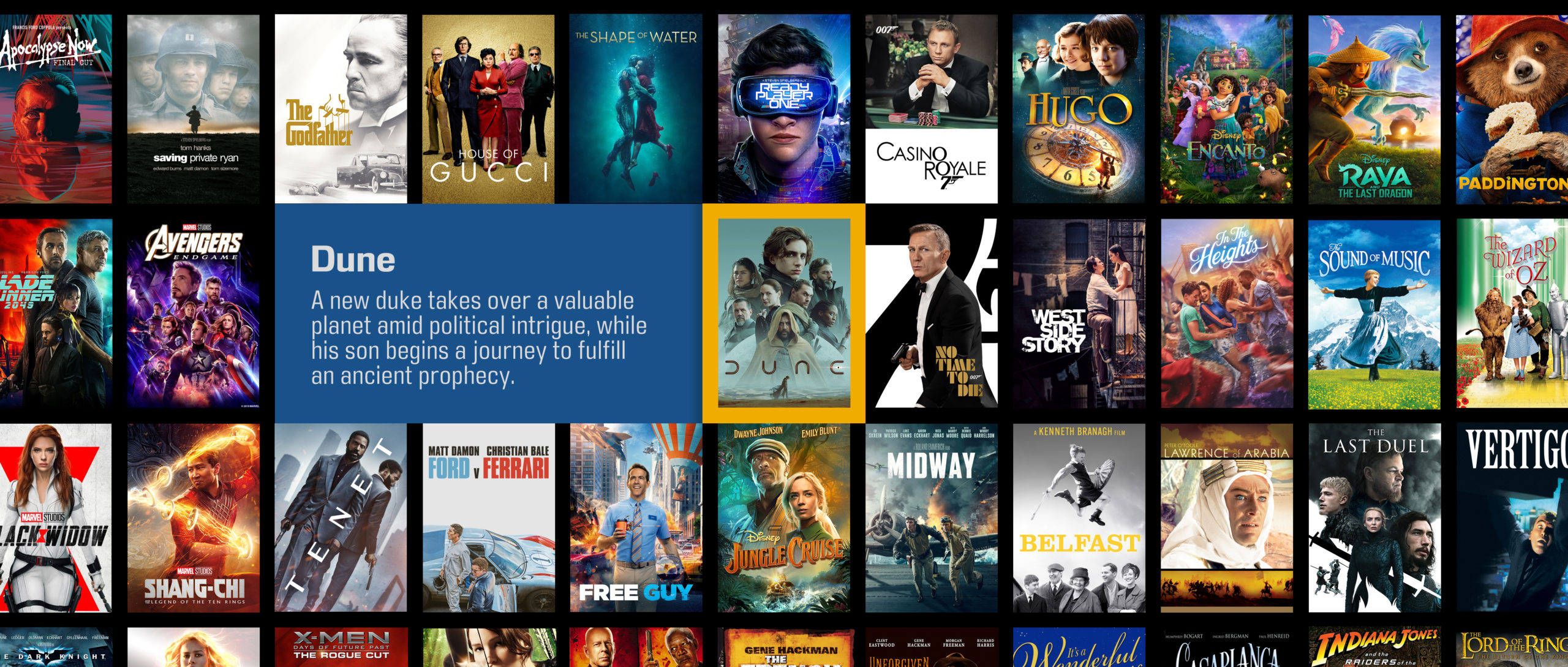
Movies: 14,000 at last count of DVD, Blu-ray, and 4K movies, TV shows and concerts. Some 700 4K titles are not even on 4K disk in the US. Kaleidescape has relationships with over 50 movie studios and they receive the master digital file from the studio, fully uncompressed and lossless. That film is reviewed to make sure their isn’t any issues with color, contrast, HDR, and audio. They then add metadata to the file regarding aspect ratios, audio tracks, particular scenes that would be “demo worthy”, even if there are post credit scenes. The reason is to increase the movie experience. They put the cues in so that if you have a control system and controllable lights, you can have the lights dim when you start up your system, and go down when the movie starts. Also there is an intermission/pause that would allow you to bring the lights up, and the same at the end of the movie, unless there are post-credit scenes. It is all about the experience.
Also, when you buy a movie and download it to your system, it isn’t a license to stream, like with Vudu and MoviesAnywhere, it is your actual property. More about steaming below.
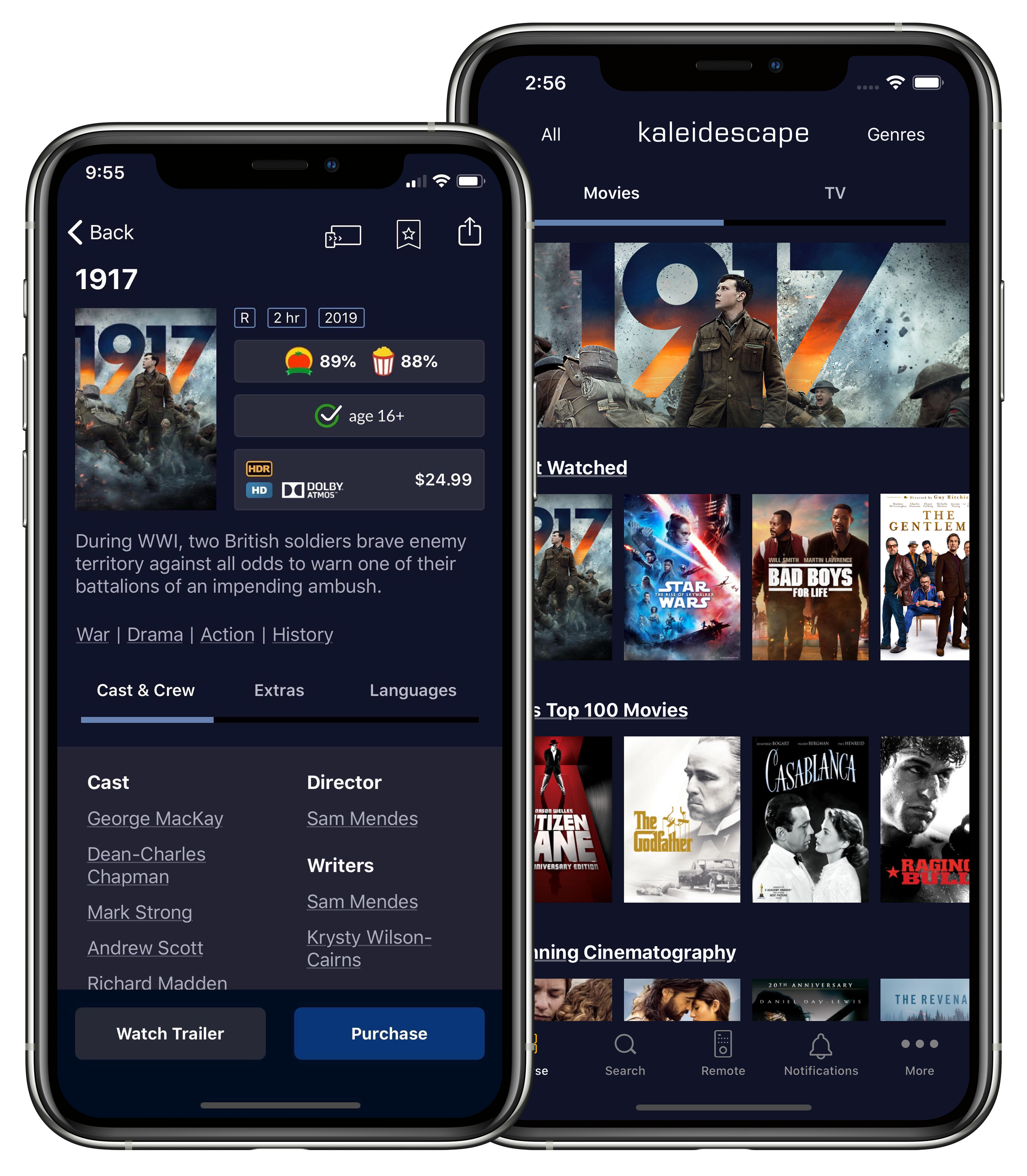
The app for iOS and Android has become the preferred method of interacting with the Kaleidescape, both inside and outside the theater. You can search, rent, and buy from the app, and also launch the Kaleidescape into the movie, along with pausing, fast forwarding, and skipping chapters. With or without a dedicated control system, this is a great app. The only thing you can’t do is actually watch the movie with the app.
Differences between Streaming, Disk, DIY, and Kaleidescape
Streaming took off during the pandemic, especially when Disney+, HBOMax, Peacock, AppleTV, Paramount+, Hulu, and good old Netflix and Amazon took advantage of people stuck at home because of COVID-19. Streaming has convenience and speed in it’s favor. This is why the redesign of the Kaleidescape UI, so you get that same experience you get with menus for streaming systems, with the exception of (besides quality) you don’t have to hop from one service to another to watch movies or TV shows. After convenience, that is when things start to fall apart during streaming.
First thing is you have to have an internet connection. You can have thousands of movies on Vudu, but without that connection, they are worthless. If you have power, you can still do disks and Kaleidescape.
Second is speed. Streaming throughput for video is around 8Mbps, this is necessary in order to prevent stuttering and buffering. Some of the devices, like the Apple 4K and the Roku Ultra, will cache the image stream to make a 15-30 second buffer to make sure you have a smooth movie. You might have gigabit internet, but streaming services throttle their streams so they don’t overload their systems, which happens whenever a brand new movie or TV show pops up. Remember, they have server farms streaming the content to millions of customers, the chart below compares the three sources. The bandwidth (throughput) on audio is the biggest detractor to streaming, to the factor of 48 times the bandwidth with a disk or Kaleidescape. There is a place for streaming, since not all movies are in the Movie Store, and if you have live TV through say, Hulu, that is the best way to watch it. But for movies and TV shows, streaming is not the best.
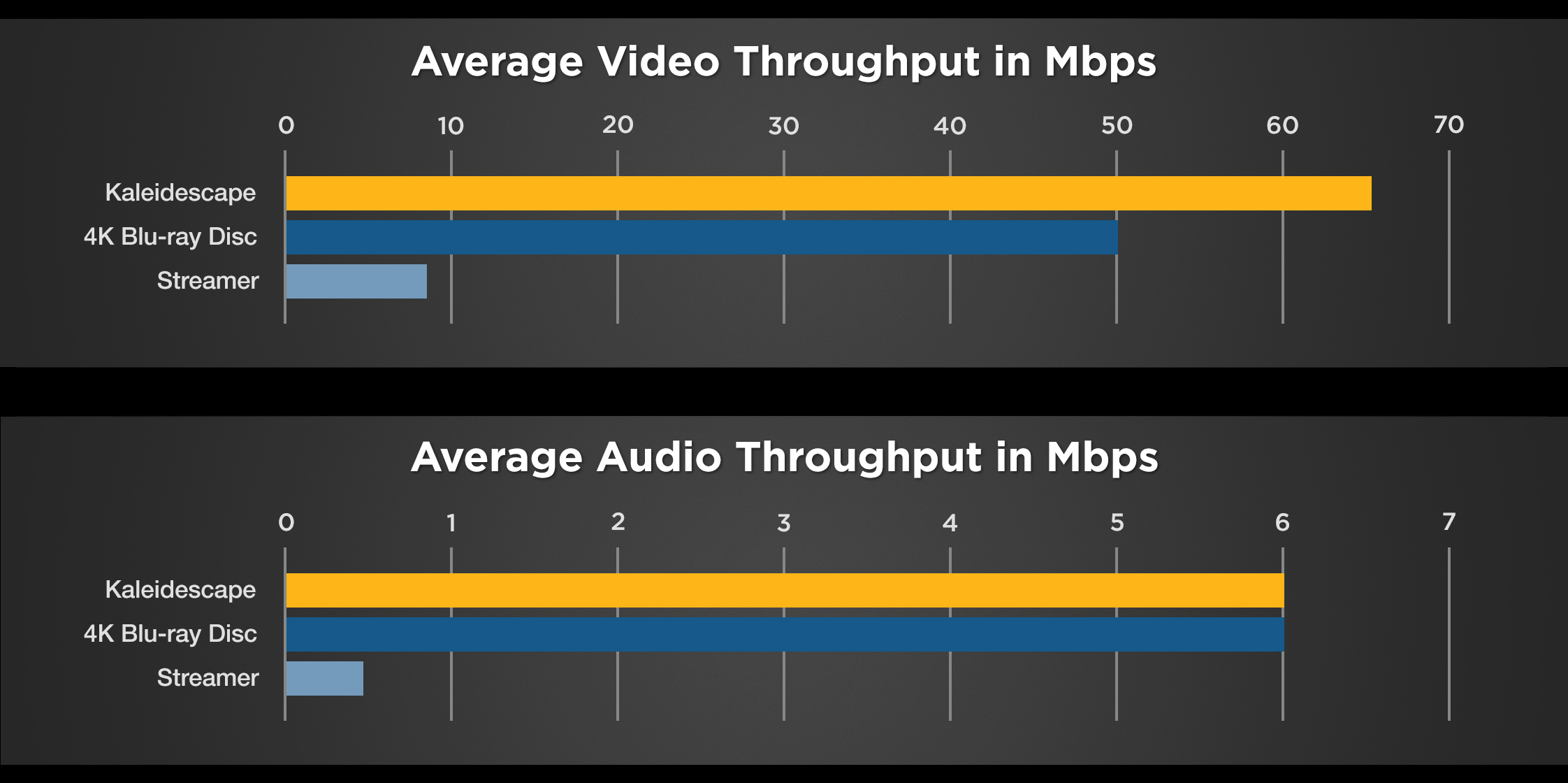
DISKS: First of all, playing a disk doesn’t require an internet connection. 4K disks have always been the “reference standard” since they first came out. With a disk, you get real Dolby Atmos bandwidth which is lacking in streaming and your bandwidth with video is 6 times that of streaming, giving you better HDR and better Wide Color Gamet.
But the whole problem of disks is convenience, storage and capacity. To play a movie you need to get up, find the movie, put it in the player, start it up, get past the menus to get to start the movie. No wonder streaming is so popular. You have to store the disks, and some people are really into collecting and have hundreds if not thousands of disks, so you need to find space for all of these.
Then you have the issue of disk capacity. You are constrained by the amount of data you can put on a disk. A dual layer disk (most common) can hold 66GB of data. Sony uses 100GB triple layer disk. The problem with the triple layer disks is players can have an issue reading the disk correctly and fingerprints and scratches will make the disk unreadable. The average 4K movie is between 60-75GB in size. Some (Avengers: Endgame) are over 100GB in size. That means something, sometimes a third of the movie, is left out. Many people say it is extras and that sort of thing, but when you have a stream of 1’s and 0’s telling your display to turn on one of 8,000,000 pixels on a screen and what color it is supposed to be, that is a lot of data. What happens is to compress the image down, it will have pixels left off instead of a dark grey, or white instead of an eggshell color, so the hit is usually in the video portion giving you a less than optimal experience. Kaleidescape starts at 6TB (about 100 4K movies) so you get the entire movie, like the studio and director wants it.
Do it yourself
There are those people (self included) who have digitized their library by ripping the 4K disks using MakeMKV, putting it on a storage device and using Kodi or Plex to catalog and watch your movies on an AppleTV, Roku Ultra or an Nvidia Sheild. First issue, time. It takes sometimes an hour or two to rip a disk to a hard drive, on your computer, which needs to be somewhat beefy to perform this, and if you use Plex, you have to have an internet connection because your profile is in the cloud. Then you have issues with updates, your computer, Plex, Android, all can cause issues or prevent you to access your movies. Plus you have to know what you are doing in ripping or you might accidently rip the Spanish version of the movie and have to redo it.
Kaleidescape
In walks Kaleidescape, bringing you the quality (or higher) of disks, with the convenience of selecting a movie to stream, while maintaining ownership over your movie like you do with a disk, unlike Vudu, Movies Anywhere, Amazon, or AppleTV. If they say, lose the license to stream a specific title, it will disappear from your catalog, even if you bought it. Same thing if you buy on Amazon Prime, but stop paying the subscription, the movie/TV show will disappear, and you have no recourse because you didn’t read the End User License Agreement which says essentially, tough luck. They know it is in there, and also know people simply accept the EULA and move on.
As of this writing (still) they don’t have an disks from the Critereon collection (although working on it) and several movies are conspicuously missing. Sometimes it isn’t the studio, but the director who prevents a movie from being listed. Case in point is some of the studios will delay putting a film on pre-order (Disney/Marvel) while it is still in the theater, while other movies in the theaters or pre-disk are online.
One of the nice features is, you can pre-order movies that are either just released in theater, or months before coming out on digital stream or streaming services or disk. When you pre-order, 99% of the movie is downloaded, then at midnight the day is is available, they will unlock the movie for you.
Also after you have purchased a movie, if there is an update (added audio track, like Atmos; scene enhancement, etc) they will let you know, and will update it for free. If you buy a Blu-ray and it gets upgraded to 4K, you get the opportunity to upgrade it for a nominal fee, like $4-$9. If you rent a movie, you get 30 days to view it, and if you buy it, you get credit for half your rental fee toward buying it. And what you rent, it what you would purchase, the exact same file.
You can also get a Season Pass for a TV show, like Last of Us or Night Court, and all the episodes will be downloaded to your system, but will only unlock the day after the show airs on TV/Streaming. Of course if your are like me you have several streaming services that will allow you to watch them anyway.
Movies cost depends on the studio, Kaleidescape doesn’t make anything on the movies, and they are studio agnostic, which makes the studios happy because Kaleidescape doesn’t have an alternative agenda (like Amazon did with buying MGM, to become a studio, or Apple becoming a studio), and makes directors happy as they don’t favor one studio over another. Most movies and TV show seasons are $14.99-$19.99 for 4K, less for Blu-ray; Disney Studios: $24.99; Warner Bros: $34.99. However, all year long, every week and every month, there are title sales. Sometimes it is a studio, sometimes it is a collection, sometimes it is just random stuff.
Just this week, 4K LOTR: Fellowship of the Ring is $9.99 (both normal and extended) when it is usually $34.99 each.
Imagine Black Friday, Amazon Prime Day and Summer Steam Sale all year round.
Additionally, if you have a large disk collection, some dealers (me) offer a disk to digital for Blu-rays and DVD’s. Not as time consuming as ripping disks, usually less than 30 seconds to have the system read the disk and catalog it, then it is ready to be purchased and/or upgraded, then downloaded to your system. This will allow the 4K upgrade for the few dollars, versus $25 or $35.
Now people who own Home Theaters can’t help themselves to show off what took them time, effort, and money. Whether it is to friends, family or neighbors, you usually have specific scenes in movies that really show off your audio and video.
If you remember above, I mentioned how the crew at Kaleidescape go through the movies to make sure it looks and sound the best. But also, there are scenes in every movie that make great demo scenes: The elevator scene in “Captain America: Winter Soldier”, the Death Star run in “A New Hope”, the temple scene in “Raiders of the Lost Ark” , or Jack Sparrows entrance in “Curse of the Black Pearl”. They have earmarked these and thousands of others. You can create scripts that you can run selecting those scenes, in the order you want, across any of the movies you have purchased, or you can easily create your own and add it to the script. All you have to do is select the script and run it and watch the amount of shock and awe you inspire.
Like I said before, you buy it, you keep it. If you delete a movie because of space issues, you can redownload it at any time. In fact, the only time you need the internet is to rent, buy, and download movies. If in the future, actual 8K content comes out (Lawrence of Arabia was scanned from the original 70mm film stock at 8K. The Nolan Batman trilogy was scanned at 8K and 11K for the IMAX scenes), if you have an 8K projector or TV, you will probably have to use this system as they say they can’t improve capacity on a disk to handle 8K (four times the resolution of 4K, which means file sizes 4 times the size. Imagine a movie nearing half a terabyte). I am looking at this as the last and best format of my favorite movies, and a future proof against the eventual oncoming of 8K content. It will just take a few years to get to that point.
One last thing, if you own a yacht, there is a specific program that will allow you to have your movies pre-loaded onto a Terra at the factory, and when it is installed, you have immediate access to your movies. If you want to add, you can when docked (since StarLink mobile doesn’t come close to the Gigabit needed.) on the dock wi-fi.
So, finally there is the cost of entry. The Kaleidescape system is not cheap. Cheap is a $99 Roku Ultra. If you go with the Strato M, it is $2k, which is much better than $9k just a couple of years ago. Move up to the Strato V and you get 4K plus up to 10 4K movies for $3995. But as I tell people who purchase the best in audio equipment, the best in video displays, why are you not providing your system with the best possible source with the ease of use of streaming? Kaleidescape gives you the best audio/video possible, providing your system, high octane digital fuel.
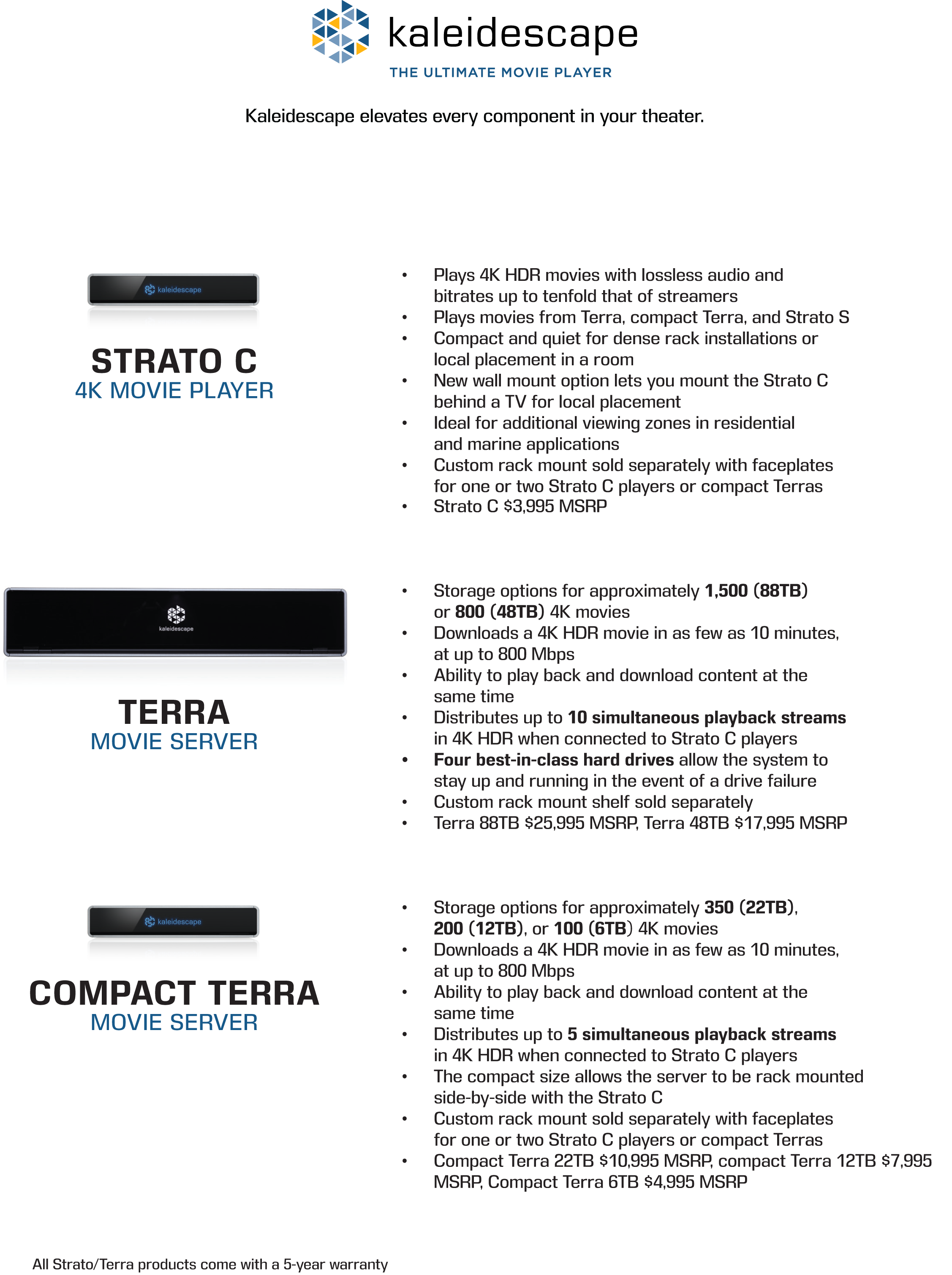


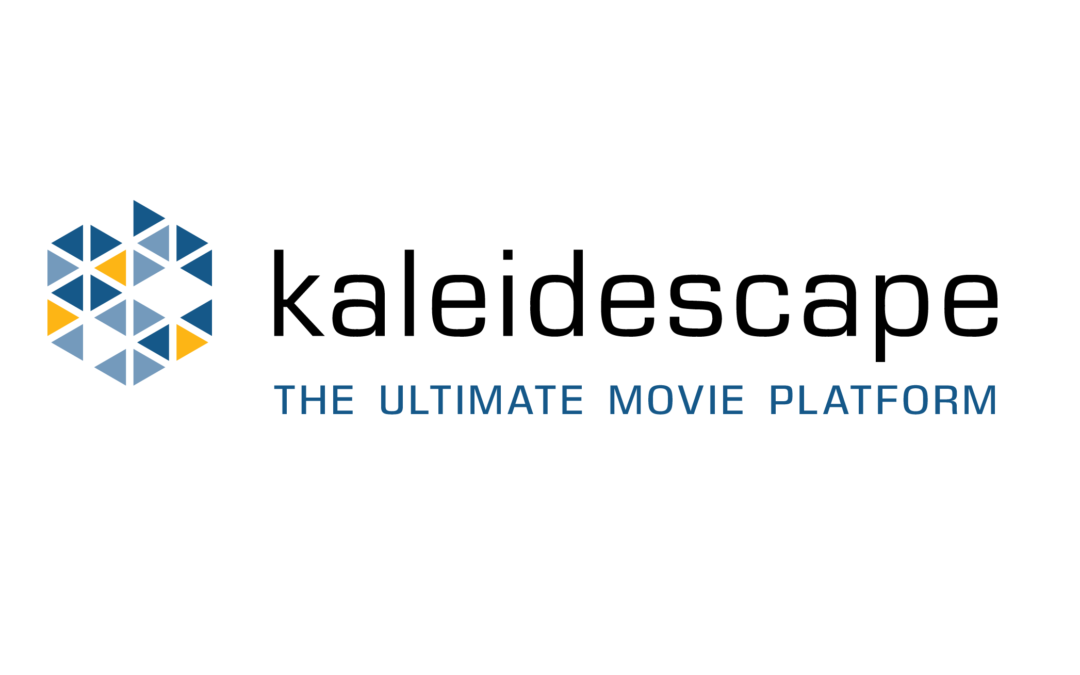
Recent Comments